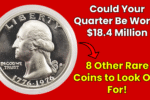The Rare Bicentennial Quarter Valued at $11 Million, Still in Circulation
When you think of a quarter, you probably think of 25 cents — just enough to buy a piece of gum or use a vending machine. But what if one of those ordinary coins in your pocket was actually worth $11 million? It might sound impossible, but a rare Bicentennial Quarter has made headlines for being that valuable. Even more surprising, there’s a chance it could still be out there in circulation.
This article takes a closer look at the story behind this incredible coin, what makes it so rare, and how you can tell if you’ve got one. So before you toss your spare change into a jar or spend that old quarter, take a moment to look more closely — it might just change your life.
What Is a Bicentennial Quarter?
In 1975 and 1976, the U.S. Mint released a special quarter to celebrate the 200th anniversary of American independence. Instead of the usual eagle on the back, this coin featured a drummer boy playing a snare drum, along with a torch and circle of stars. The front of the coin still shows George Washington, but the date is marked as 1776–1976 to honor the Bicentennial.
Millions of these coins were made, and they were put into regular circulation. Most of them are still only worth face value — just 25 cents. However, a small number of rare versions were struck with special errors, unusual materials, or limited quantities, and those are the ones collectors are hunting for.
One such quarter has been valued at $11 million, thanks to a mix of mystery, rarity, and historical value.
Why Is This Bicentennial Quarter Worth $11 Million?
You may wonder, how could a 25-cent coin be worth more than a mansion? Well, here are the main reasons behind this coin’s enormous value:
-
Minting Error or Unique Material – Some rare coins were accidentally struck using the wrong metal, like silver or experimental alloys.
-
Limited Edition – A few Bicentennial Quarters were made for testing or presentation and were never meant for public use.
-
Perfect Condition – A flawless, uncirculated coin in mint state can increase the value dramatically.
-
Collector Demand – High interest from serious collectors can drive up prices quickly.
It’s believed that the $11 million quarter falls into one or more of these rare categories. Its extreme rarity makes it a legend in the coin-collecting world.
Key Features of the $11 Million Bicentennial Quarter
| Feature | Details |
|---|---|
| Coin Type | Bicentennial Quarter |
| Year | 1776–1976 (dual date) |
| Design | Drummer boy reverse, Washington obverse |
| Rarity | Possibly one-of-a-kind or few known |
| Composition | Believed to be rare alloy or error strike |
| Estimated Value | $11 million |
| Circulation Status | Believed to still be in public hands |
How to Spot the Rare Bicentennial Quarter
So, what should you be looking for if you think you might have a valuable quarter? Here are some simple signs to watch for:
-
Date – Must read 1776–1976.
-
Design – The back should show a drummer boy with a star circle and a torch.
-
Mint Mark – Look for unusual or missing mint marks near Washington’s ponytail.
-
Color and Weight – If the coin looks silver and doesn’t show the typical copper edge, it might be struck on a different metal.
-
Condition – The sharper the detail and cleaner the coin, the more it might be worth.
Even if your coin doesn’t match all these points, it may still be valuable. When in doubt, take it to a professional coin dealer for inspection.
What Makes Rare Coins So Valuable?
Rare coins gain value for several reasons:
-
Scarcity: The fewer there are, the higher the demand.
-
Errors: Mistakes made at the mint can make a coin one-of-a-kind.
-
Condition: Coins in perfect condition can be worth many times more than worn ones.
-
Historical Significance: Coins tied to special events or periods (like the Bicentennial) often become collector favorites.
-
Market Demand: As more people look for rare coins, prices go up.
The $11 million quarter is the perfect storm of all these qualities — ultra-rare, possibly one-of-a-kind, and tied to a major national celebration.
FAQs
Q1: Are all Bicentennial Quarters valuable?
A: No. Most are common and only worth their face value. Only rare versions with mint errors, special metal, or perfect condition have high value.
Q2: How can I tell if my quarter is the rare $11 million one?
A: Check for unusual features: no mint mark, silver color, odd weight, or flawless condition. If anything seems different, consult a coin expert.
Q3: Can I still find this rare quarter in circulation?
A: While extremely unlikely, it’s still possible. Some rare coins remain in public hands because people don’t recognize their value.
Q4: Should I clean a coin I think is valuable?
A: No. Cleaning can damage the coin and reduce its value. Keep it in its original state and let a professional examine it.
Q5: Where can I get a coin appraised?
A: Visit a certified coin dealer, a local coin show, or use a professional grading service like PCGS or NGC for expert advice.
Final Thoughts
The idea of finding a $11 million quarter might sound like a fantasy, but history has proven that valuable coins do slip through the cracks. One rare Bicentennial Quarter with unusual features or a mint error could be worth a life-changing amount of money — and it might just be sitting in someone’s piggy bank or pocket right now.
So before you ignore your loose change or spend an old coin without a second thought, take a moment to look closely. You never know — you could be holding a hidden treasure worth more than you ever imagined.



